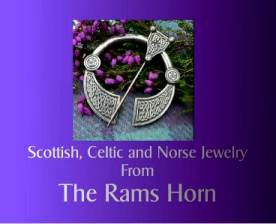The Ram's Horn Calls
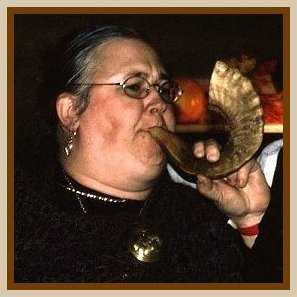
Beth Boyle Blows The Rams Horn (Bukkehorn)
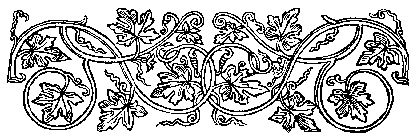
Two Norwegian bukkehorn songs
All Rams Horns for blowing are not Shofars as used in Hebrew Worship. In Norway the ram's horn and wooden horn (Bukkehorn and lur) are traditional instruments. The bukkehorn is an instrument type which is found over large parts of the world. It was traditionally used on high mountain summer dairy farms by herders at least since medieval times. There are two main types of bukkehorn. The more common type has a plain hole for a mouthpiece and is blown as a brass instrument, with from two to three up to eight finger holes. The other type is called tungehorn ("tongue horn"), and is played like a clarinet; it has a reed made of birch bark or juniper in the mouthpiece. There is far less knowledge of the ritual use of these instruments than of their function as "tools". In Norway, both these instruments and their history are associated with mountain farms and shepherds. The ram's horn was, from its earliest days, a practical tool rather than a musical instrument, used as a means of giving warnings and signals. Later horns were made with two, three, and up to eight finger holes. It is also called the trumpet horn (trompethorn). A variation on the ram's horn is known as the tongue horn (tungehorn). It has a reed made of juniper wood that is similar to a clarinet reed, and has from four to eight finger holes.
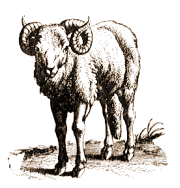
The history of the wooden horn can be traced back to the Bronze Age. The wooden horn was an important tool at sea in ancient times, used as a means of communication between boats. There are three main categories of wooden horns: those carved out of a solid piece of wood, those carved out of a piece of wood that has been separated and then bound together, and those that are merely lashed together from a strip of birch bark. Through the technique of overblowing on an ordinary wooden horn, it is possible to produce partial notes up to the eighth upper partial of the natural scale, or up to the twelfth partial if the horn is very long.
As far as we can tell, instruments made of bone, wood, and animal horn were used by our earliest ancestors and have continued to have uses until our own times. From the beginning of, the horn was more a practical tool than a musical instrument. It was used for scaring wild animals that threatened a shepherd`s flock or for signaling. Later, finger holes were added to the instruments, at first 2-3 and then up to 8. With this innovation it became possible to play simple melodies. Today, the instrument is usually called ram`s horn because the male goat has been the main provider of raw materials. Tungehorn (lit. tongue horn) is also a common word in ram`s horn tradition. This instrumental variation has a juniper sliver at the blowing end mounted in the same manner as the reed of a clarinet. It usually has 4-8 finger holes.
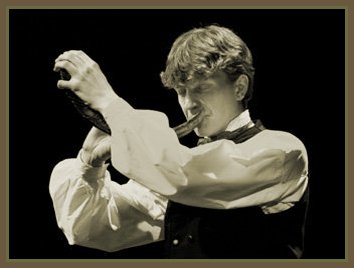
Knut Skrindo
Knut Skrindo is among the few who play the bukkehorn (goat’s horn). He has played since the age of 14, and has evolved his own style and sound on his various horns, which he makes himself.
While the ram`s horn was used first and foremost by shepherds, the lur (similar to an alpenhorn) was the instrument of the dairy maids (budeia) who tended the summer farms. The lur`s history can also be traced back to the Middle Ages. We know that the lur was an important tool at sea in olden times, where it was used to communicate between boats. In the Oseberg ship, an elaborate grave from Viking times, a wooden tube was found that researchers believe was a lur. We divide lurs into 3 groups based on the construction technique: lurs that are hollowed out of a single piece of wood, lurs that are made from a piece of wood that is first split and later bound back together, and lurs that are simply bound together by a birch strip. The lur is blown like a trumpet; the thin end where you blow is usually formed something like the mouthpiece of a trumpet. On an ordinary lur it is possible, using overblowing technique, to produce pitches ranging from the 2nd up to the 6th or 8th harmonic of the harmonic series (natural scale). If the lur is very long, it is possible to produce all the way up to the 12th harmonic.
BUGLE, SHEPHERD'S HORN
Ancient Hungarians used the horn as a signaling device and also as a symbol of dignity. The swineherd's horn was made from the 80 cm long horn of the Hungarian grey cattle. In some regions the herdsmen decorated their instrument. The horns produce an extraordinarily high tune.
The wooden bugle is called a bugle (k?rt) by the Sz?kelys, and a water pipe (v?ziduda) by the folk of the Great Plain. They are from 50 to 200 cm long and are made of pine, poplar, birch or elder wood. In Transylvania the bark of the linden tree is also used. Both bugles had to be soaked in water for a good sound. The horns and bugles were used by fishermen, millers, rafters, sailors for signaling, and by herdsmen to scare off wild animals. According to folk tradition the custom of noisemaking is a remnant of ancient rituals of cleansing, keeping sickness and enemies away. Bugles were also used to salute the New Year and Spring or simply to chat with far away neighbors on quiet evenings.
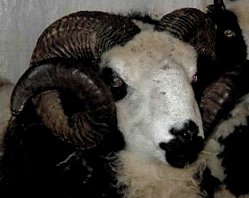
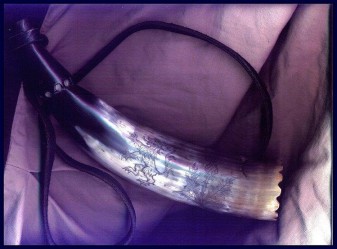
NORGE
Salmenes 23
1 En salme av David. Herren er min hyrde, mig fattes intet.
2 Han lar mig ligge i grønne enger, han leder mig til hvilens vann.
3 Han vederkveger min sjel, han fører mig på rettferdighets stier for sitt navns skyld.
4 Om jeg enn skulde vandre i dødsskyggens dal, frykter jeg ikke for ondt; for du er med mig, din kjepp og din stav de trøster mig.
5 Du dekker bord for mig like for mine fienders øine, du salver mitt hode med olje; mitt beger flyter over.
6 Bare godt og miskunnhet skal efterjage mig alle mitt livs dager, og jeg skal bo i Herrens hus gjennem lange tider.
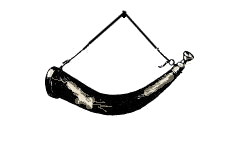
Sheep and Shepherds in Medieval Times
Sheep (called bleating chete) are one of the most common and productive types of livestock in the medieval culture. They require very little to raise as they survive on grazing throughout most of the year. They produce milk (1/2 gallon per day), wool (3 pounds per year), meat (15 pounds per lamb) and hides which are made into vellum for writing material.
Shepherd FRP characters and shepherding skill can be used to tell accurate location (breeds and markings of sheep), they can be used for sources of income, and they can tell the seasons by the condition of sheep. Shepherds can be used for adventure lead-ins as many village by-laws deal with livestock (and sheep in particular) and shepherds have many friends among merchants (butchers, weavers, cloth merchants, etc.). Shepherd wagons can be used for a base of operations while traveling in rural areas.
BREEDS
On Harn, there are twenty major breeds of sheep separated into the categories of mountain, hill and lowland breeds. There are also countless crossbreeds as each shepherd tries to create the best sheep for the location and resulting products. Each type of sheep survives best in it's native environment and won't survive at all in environments that are too different.
Mountain Breeds
Mountain breeds and where they are most commonly located are Orbaalese Blackface (Orbaal), Ternu Horn (Tharda), Rayesha Mountain (Rethem), Felsha Gritstone (Kaldor), Shorkin Herdwick (Azadmere) and Sethadale (Chybisa). Mountain breeds lamb a month later than hill breeds and their wool is courser. They can survive only in the mountains and grassy hills.
HILL BREEDS
Grassy hill breeds include Kathela Hill (Kaldor), Shava Forest (Evael), Kanday Speckled Face (Kanday) and Cheviot (Tharda). These are the most common breeds and they can survive in the grassy hills and the lowlands (except for marshy areas).
LOWLAND BREEDS
Lowland breeds include Southdown (Melderyn), Ryeland (Kaldor), Athul Down (Tharda), Tharda Horn (Tharda), Peran Horn (Rethem), Anadel Down (Melderyn), Horadir (Chybisa), Nuthela (Orbaal), Ilmen Marsh (Kaldor) and Tharda Longwooled (Tharda). Lowland breeds can only survive in level areas and are the only breeds that can survive in the marshes.
Calendar
Nuzyael
This is the month when most of the hill breeds of ewe give birth. The mountain breeds lamb a month later and the lowland breeds a month earlier. Each ewe has one to three lambs weighing an average of ten pounds. If there are three lambs, one must be fostered or it won't survive.
Peonu
Lambs are castrated and their tails are cut off and sacrificed to Peoni. Special fences are used that the lambs can creep through but the ewes can't (this is called creep feeding). This allows the lambs to have the best grazing while the ewes are brought back to maintenance feeding.
KELEN
The flock is moved to fresh pasture and the sheep are dagged to prepare for shearing. Dagging is the process of removing the dirty wool at the back end so it doesn't foul the wool to be sold. Good pasture supports fifteen ewes and their lambs per acre without additional feed.
Nolus
Sheep are sheared and lambs are sold to be slaughtered. Lambs sold at this time average 40 pounds in weight. Wool produced averages one pound for mountain breeds, one and three quarters pounds for lowland breeds, two and a half pounds for hill breeds and two and three quarters pounds for long wooled breeds.
Larane
Lambs that are kept to replenish the herd are weaned at this time. Ewes that are barren or too old are sold to be slaughtered. The average weight of a ewe is 125 pounds of which 35% is meat. The woolly skins (called fells) are sold to hideworkers to make heavy coats as they are too thick to be made into vellum.
Agrazhar
Ewes and rams are selected for breeding. Rams are mated after they are a year old. Ewes are mated after they are two years old. One ram can service thirty ewes and ewes can be mated for five years.
Azura
Breed ewes are flushed (fed extra food), dipped and dagged to prevent parasites and diseases. Any unknown sheep disease is referred to as murrain. When sheep are not just grazing, they're fed a combination of one pound hay, eight pounds kale or silage and one pound concentrated food (three parts grain and one part beans) per sheep.
Halane
To honor the goddess Halea, the rams are turned in with the ewes to breed. Ewes are in heat for 24 hours once every 16 days. The sheep are marked by notching their ears, painting colors on their body or branding with tar. Careful records are kept of the markings to determine ownership and breeding history.
Savor
All of the village sheep are penned on the lord's demense to get the benefit of their manure. This is sometimes resented but it is enforced by the manor court with fines for those who don't oblige. Ewes are gradually fed more in preparation for lambing.
Morgat
Lambing pens of thatched hurdles are made in sheltered fields to prepare for lambing next month. The end of this month is when the sheep are again returned to the fields.
Equipment
Shepherds use a covered wagon (in the style of a gypsy wagon) for shelter while following the flock and to be near during lambing. Unlike swine (which can defend themselves) sheep need a shepherd to protect them from preditors and sheep thieves (called bleating culls). In the wagon is a straw matress, a small iron stove (for cooking and heating), a stool (for milking) and cooking utensils. Shepherd tools include lamb feeding bottles (a clay, pewter or glass bottle with a cork and a pipe in the neck), a shepherd's staff (either neck crook or leg crook), dipping staff (like a crook with blunt ends), fold beetle (wooden mallet for hammering in hurdles), fold bars (for making holes and for hammering in hurdles), sheep bells (clucket, canister, crotal or rumbler) sheep bows (yoke to restrain the sheep), and hurdles (wooden frames tied to the outside of the wagon).
Miscellaneous notes
Male lambs (called wethers) are often castrated to produce a finer type of wool for four to five years.
If sheep (or other livestock) wander onto the lord's land without license (called waif and stray), the lord's men can keep them and sell them and keep the profit or charge 2d per day to care for them.
Shepherds can tell the age of sheep by examining their lower teeth. They grow two adult (larger) teeth per year. Shepherds count their sheep in pairs by a rhyming chant such as "one-erum, two-erum, cog-erum, shu-erum, shith-erum, shath-erum, wine-berry, wagtail, terrydiddle, den". This counts ten pairs which make a score.
The people of Tharda where the first to use sheep shears. Before that, wool was plucked from the sheep when they molted. Kaldorians where the first to do extensive cross-breeding.
Shoplifters are sometimes called sheep shearer's and garrulous people are called sheep headed.
copyright 2002 , Jim & Beth Boyle, All Rights Reserved
No part of this website may be used for any purpose ( including using images )
without written consent from The Rams Horn
In Loving Memory of Harold and Trygve Tveter
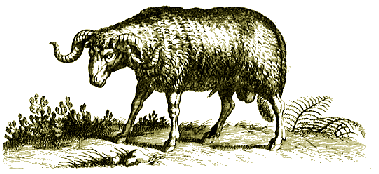
"Pasce Oves Meas"
Feed my sheep

